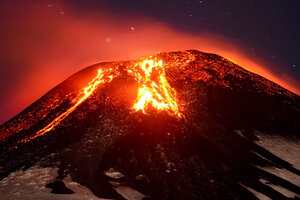Could that volcano in Chile slow global warming?
Material ejected in eruptions of volcanoes like Chile's Villarica could reflect heat back into space, mitigating some of the greenhouse effect produced by human activity.

The Villarica volcano erupts near Pucon, Chile, early Tuesday. The Villarica volcano erupted Tuesday around 3 a.m. local time (0600 GMT), according to the National Emergency Office, which issued a red alert and ordered evacuations.
Lautaro Salinas/AP
You don't often hear "volcanic eruption" and "cooling" in the same sentence, but the dramatic eruption of the Villarica volcano in southern Chile could actually help slow global warming.
Villarica, a 9,000 foot volcano in Chile's Central Valley, erupted around 3 a.m. Tuesday, spewing smoke and molten rock and prompting the Chile's National Emergency Office to order thousands to evacuate, according to the Associated Press. About 3,500 people have been evacuated so far, including tourists, according to published reports.
The material ejected by the volcano does more than just imperil aircraft and frighten spectators; sometimes, if enough of it goes high enough, it can produce a global cooling effect that persists for years.
"Yes, this can be the planet's own form of climate engineering," says Phil Rasch, chief scientist for climate science at the Pacific Northwest National Laboratory. "Scientists can learn something about how the planet will be affected the consequences of a volcanic eruption on the Earth."
Dr. Rasch explains that explosive eruptions like Villarica can sometimes inject a large volume of dust and gaseous material – mostly sulfur dioxide – into the stratosphere.While volcanic pollution in the lower atmosphere dissipates within days, thanks to rainfall and gravity, stratospheric pollution can hang around for several years, gradually spreading to cover much of the globe.
In the stratosphere, the sulfur dioxide converts into sulphuric acid aerosols, which reflect sunlight – and its attendant heat – back to space.
The scientific term for the proportion of reflected sunlight is albedo. Too much albedo, and Earth runs the risk of becoming an inhospitable snowball. Too little, and the planet starts to cook.
Rasch, who does not believe that this most recent eruption will produce a global cooling effect, worked with the National Academy of Sciences on one of a flurry of research reports on Climate Intervention over the past year. He says that his work details the possible benefits of climate engineering via various methods, including albedo modification.
"It depends on how strong the volcano is and how deeply into the atmosphere it injects the sulphur dioxide – 20 kilometers would likely have that kind of cooling effect," Rasch says. "The amplification of the cooling also depends on the volume of gasses injected as well."
“Because data is still being gathered on the emissions of the Villarica event we can’t say yet if it will have any real impact on climate change,” says Amanda Maxwell, Latin America Project Director for the Natural Resources Defense Council in a phone interview.
According to the Global Climate Change website, observational and modeling studies show it the “likely effect of recent volcanic eruptions suggest that an individual eruption may cause a global cooling of up to 0.3°C, with the effects lasting 1 to 2 years.”
NASA Goddard Institute for Space Studies Director, Dr. Gavin Schmidt says in an email that he believes “the eruption of the Chilean volcano was too small and the volcano was not of an altitude to affect climate.”
According to San Diego State University, there is “a clear correlation between historic eruptions and subsequent years of cold climate conditions.”
Some well-known historic examples, according to SDSU, of global cooling that came as the result of eruptions far more massive than Villarica are:
The Laki eruption in 1783, the largest outpouring of basalt lava in historic times, is considered a likely culprit in “haze-effect global cooling” which took place soon thereafter. “The eastern US recorded the lowest-ever winter average temperature in 1783-84, about 4.8°C below the 225-year average. Europe also experienced an abnormally severe winter,” according to the SDSU site.
When Mt. Tambora in Indonesia erupted in 1815 the result was a frosty spring and cold summer in 1816, which became known historically as “The year without a summer.”
The famed Krakatau eruption in 1883, also in Indonesian resulted, months later, in global cooling effect that produced “unseasonably cool weather, brilliant sunsets, and prolonged twilights due to the spread of aerosols throughout the stratosphere. The brilliant sunsets are typical of atmospheric haze.”
Editor's note: This story has updated to clarify that Dr. Rasch does not believe that this particular eruption will cause cooling.

